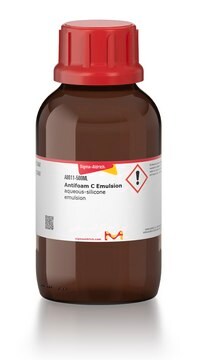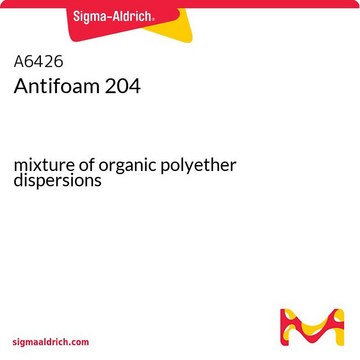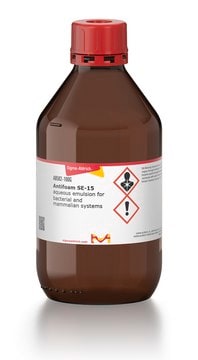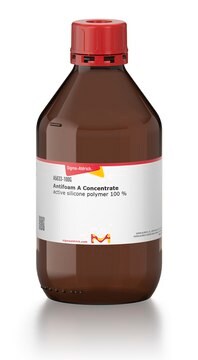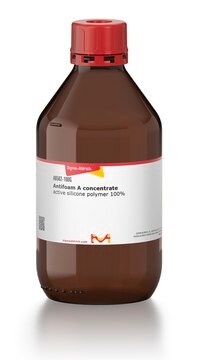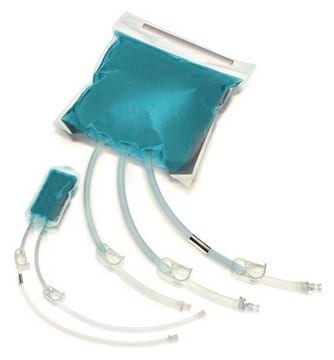Wszystkie zdjęcia(1)
Kluczowe dokumenty
A5757
Antifoam B Emulsion
aqueous-silicone emulsion
Synonim(y):
Antifoaming agent B
Zaloguj sięWyświetlanie cen organizacyjnych i kontraktowych
About This Item
Kod UNSPSC:
12161900
NACRES:
NA.25
Polecane produkty
Poziom jakości
Formularz
emulsion
zawiera
emulsifier (different from those present in Antifoam A emulsion)
metody
cell culture | hybridoma: suitable
microbiological culture: suitable
Opis ogólny
Antifoam eliminates excessive foaming formed during impingement, due to proteins and/or carbohydrates in the collection medium. Antifoam B emulsion is a silicone based antifoam. Antifoam B emulsion does not affect the growth of bacteria. Antifoam B emulsion functions as an antifoaming agent in shake flask culture of bacteria.
Zastosowanie
Antifoam B emulsion has been used:
- to enhance collection efficiency in collection media
- as a component in stress granule lysis buffer to reduce foaming, in host cell lysis buffer to reduce foaming caused by detergents
- to improve solubility of antibiotics
- as a foaming controls in bacterial growth media
Inne uwagi
A 10% aqueous emulsion of polydimethylsiloxane
Ta strona może zawierać tekst przetłumaczony maszynowo.
Kod klasy składowania
10 - Combustible liquids
Klasa zagrożenia wodnego (WGK)
WGK 3
Temperatura zapłonu (°F)
>214.0 °F - closed cup
Temperatura zapłonu (°C)
> 101.1 °C - closed cup
Wybierz jedną z najnowszych wersji:
Masz już ten produkt?
Dokumenty związane z niedawno zakupionymi produktami zostały zamieszczone w Bibliotece dokumentów.
Klienci oglądali również te produkty
Isolation of yeast and mammalian stress granule cores
Wheeler JR, et al.
Methods, 126, 12-17 (2017)
Celeste J Brown et al.
PloS one, 8(3), e60401-e60401 (2013-03-28)
Observing organisms that evolve in response to strong selection over very short time scales allows the determination of the molecular mechanisms underlying adaptation. Although dissecting these molecular mechanisms is expensive and time-consuming, general patterns can be detected from repeated experiments
Separation of metabolic supply and demand: aerobic glycolysis as a normal physiological response to fluctuating energetic demands in the membrane
Epstein T, et al.
Cancer & Metabolism, 2(1), 7-7 (2014)
High-Throughput Quantification of Bacterial-Cell Interactions Using Virtual Colony Counts
Hoffmann S, et al.
Frontiers in Cellular and Infection Microbiology, 8, 43-43 (2018)
Fermentation pH modulates the size distributions and functional properties of Gluconobacter albidus TMW 2.1191 levan
Ua-Arak T, et al.
Frontiers in Microbiology, 8, 807-807 (2017)
Nasz zespół naukowców ma doświadczenie we wszystkich obszarach badań, w tym w naukach przyrodniczych, materiałoznawstwie, syntezie chemicznej, chromatografii, analityce i wielu innych dziedzinach.
Skontaktuj się z zespołem ds. pomocy technicznej